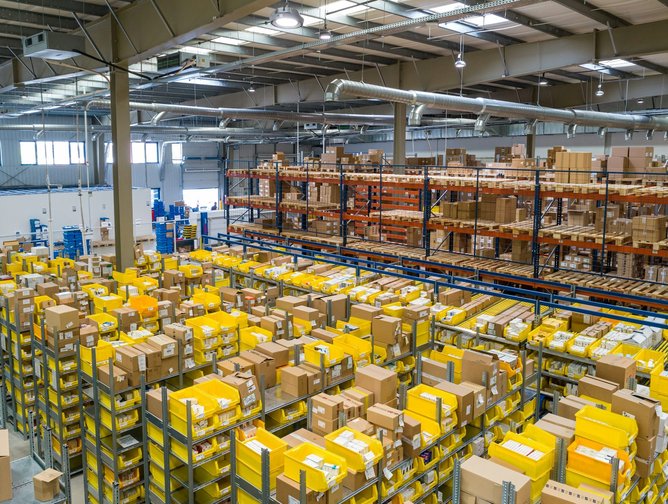Nokia AIMS: Transforming Warehouse Inventory Management

E-commerce has grown in explosive fashion over the past few years, to the extent it is now projected to reach a market volume of US$5.3tn by 2028 – representing a CAGR of almost 10% from 2024.
This spike in demand inevitably means the need for warehouse, supply chain and logistics operators to rapidly fulfil orders is at an all-time high.
As a result, the importance of accurate and efficient inventory management cannot be overemphasised if companies are serious about achieving success in today’s ultra-competitive business environment.
Firms trapped in cycle of inefficiency
The downside for e-commerce firms is that inventory management remains a major liability in warehouse operations, as Paul Heitlinger, General Manager of Nokia AIMS, explains.
“Traditional, manual inventory counting processes continue to be error prone,” says Paul.
“While cycle counting is a necessary chore to audit stock and resolve inventory errors, it’s inundated with inaccuracies as it often relies on manual, human labour.”

Paul highlights that, when inventory gets lost – otherwise known as shrinkage – the burden falls to human workers to take on the low-value task of conducting time-consuming investigations to find these misplaced items.
Or, even worse, items stay lost until they are eventually found months later during another cycle count or a full wall-to-wall count.
“Imagine having to spend hours manually counting each item, bin by bin, instead of undertaking productive tasks,” Paul goes on.
“Many workers understandably find this role undesirable, leading to high staff turnover and additional training costs. Ultimately, this creates high OpEx costs that are further exacerbated by worker shortages, leaving businesses in a never-ending cycle of inefficiencies.”
Nokia AIMS provides seamless warehouse management
The tricky task of keeping track of inventory is exactly what Nokia’s new venture, Automated Inventory Management System (AIMS), seeks to solve.
AIMS fuses cutting-edge, AI-enabled autonomous drones, computer vision-based localisation, barcode scanning and data analytics into one seamless warehouse management service. This automates the cycle-counting process, providing increased efficiency, accuracy and a substantial ROI.
Once launched, a single AIMS drone can fully scan a 250,000 sq ft warehouse in approximately two to four weeks. They fly autonomously through warehouses, scanning inventory up to seven times faster than humans.
What’s more, warehouse operators can schedule the drones to scan any time and any aisles – including overnight or during down times – resulting in minimal disruption to operations.
“AIMS provides one true picture that optimises inventory management processes without costly and error-prone human intervention,” Paul continues. “Imagine managers walking into their offices each morning to find a snapshot of their actual inventory ready to view.
“This up-to-date data enables managers to quickly and accurately review inventory statuses or locations, identify mismatches and empty bin locations – all from the comfort of their office, or even while sitting on the beach.
“This saves valuable time and resources, which ultimately allows businesses to focus on doing what they do best – shipping products rather than being slowed down by tiresome tasks.”
Aiding business growth
In truth, the performance of AIMS stretches far beyond efficiency and accuracy.
It represents a strategic investment given it is projected to give organisations a substantial ROI of at least 40% over three years.
Paul reveals that, during the first few months of operation at customer sites, AIMS has already proven its worth by uncovering tens of thousands of dollars worth of lost inventory.
By incorporating an automated inventory management service and eliminating the need for extensive manual labour, businesses are experiencing significant declines in wage, shrinkage and equipment maintenance costs.
OpEx is further lowered by a reduction in accidents and the fact workers can be redeployed to more productive, customer-facing tasks where they add strategic value.
“Such recovered resources can now go towards business growth initiatives and financial gains,” Paul says. “This not only emphasises the immediate impact of this technology but also underscores the long-term benefits that businesses can accrue by embracing solutions like AIMS.”
He concludes: “Looking at the big picture, industry factors like rapid fulfilment demands, increasing property costs, labour shortages and high inflation will continue to impact warehouse operations.
“AIMS won’t be able to solve all a warehouse’s cost drivers, but it can solve inventory management challenges, so they can focus on high-value priorities that maintain business growth and continuity.”
******
Check out the latest edition of Supply Chain Magazine and sign up to our global conference series – Procurement and SupplyChain LIVE 2024.
******
Supply Chain Digital is a BizClik brand.






